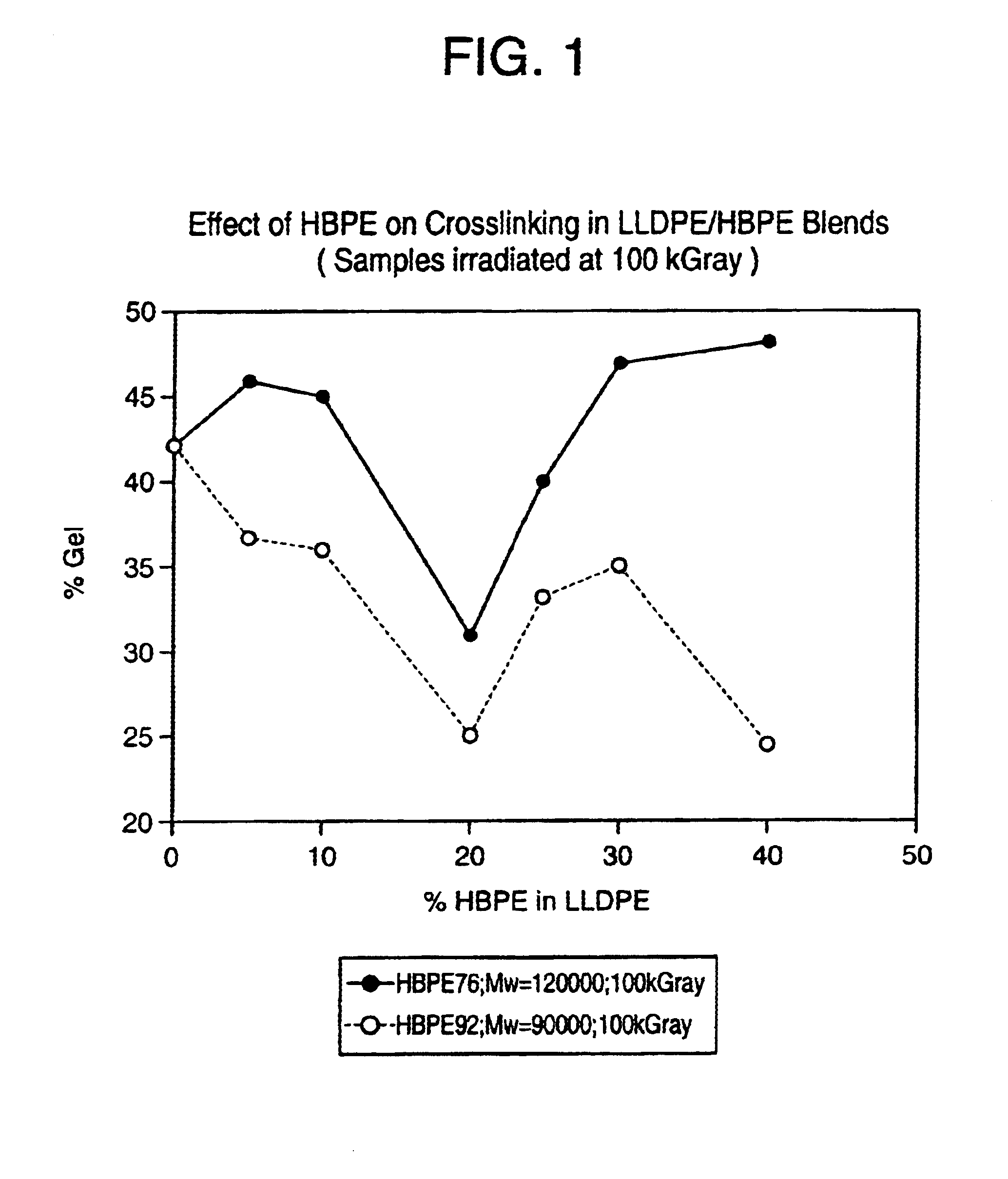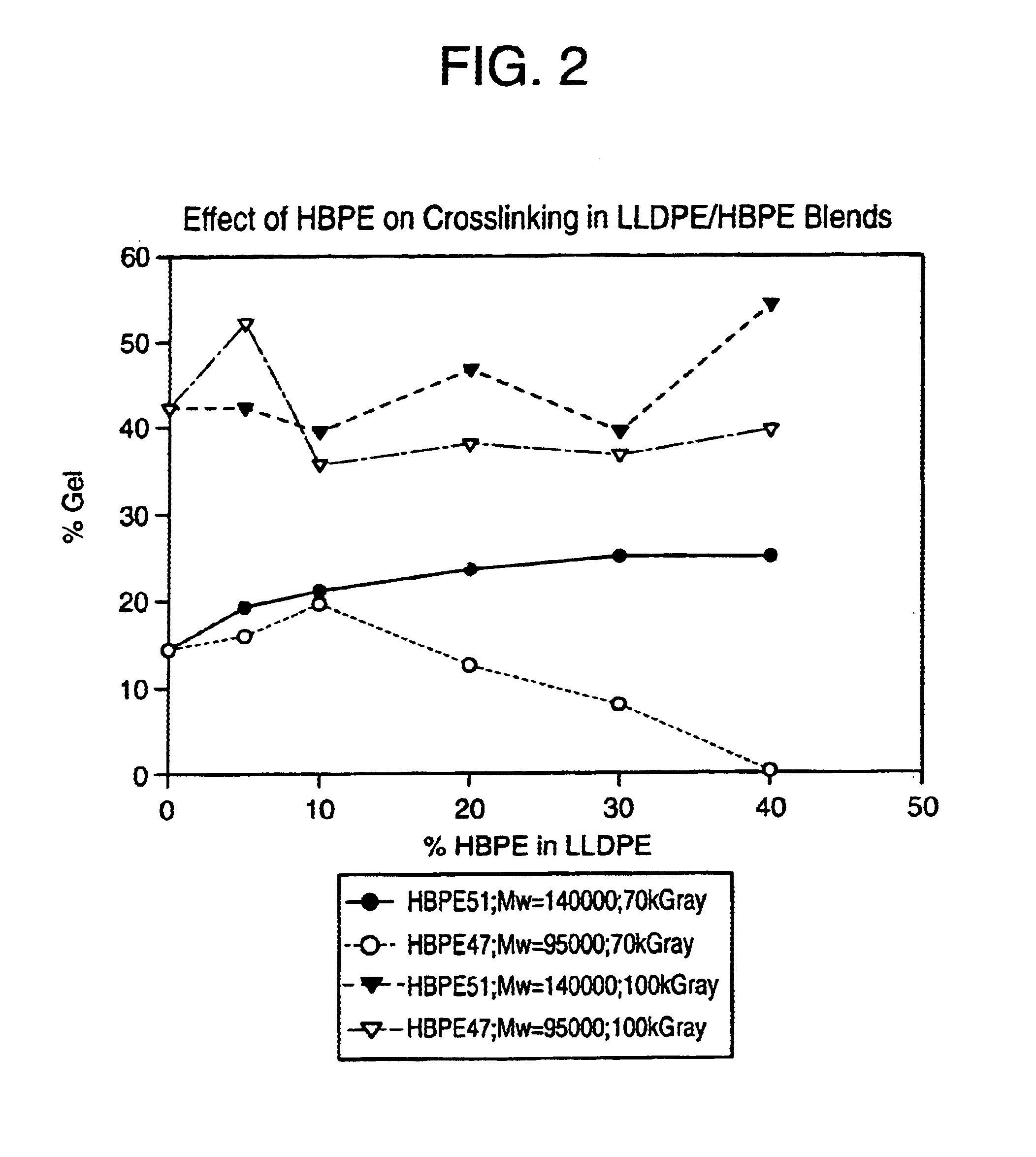Irradiated multilayer film having seal layer containing hyperbranched polymer
- Summary
- Abstract
- Description
- Claims
- Application Information
AI Technical Summary
Benefits of technology
Problems solved by technology
Method used
Image
Examples
example no.1
EXAMPLE NO. 1
Crosslinking Suppression of Highly Branched Polyethylenes in Blends with Linear Low Density Polyethylene, Irradiated at 70 KiloGrays
A highly branched amorphous homogeneous polyethylene was prepared, having 76 branches per 1000 carbon atoms (“HBPE-76”, with 76 branches per 1000 carbon atoms corresponding with 90 branches per 1000 methylene groups), a molecular weight of 120,000, a melt index of 1.4 g / 10 min, and a density of 0.869 g / cc. The HBPE-76 was prepared with a Ni(II) α-diimine catalyst.
Throughout this document, the following convention is used for naming alpha-diimine complexes of metals, and the alpha-diimine itself. The alpha-diimine is indicated by the letters “DAB”. To the left of the “DAB” are the two groups attached to the nitrogen atoms. To the right of the “DAB” are the groups on the two carbon atoms of the alpha-diimine group. To the right of all this appears the metal and ligands attached to the metal.
The catalyst [(2-(i-Pr), 6-Me-Ph)2DABMe2] NiBr2 was ...
example no.2
EXAMPLE NO. 2
Crosslinking Suppression of other Highly Branched Polyethylenes in Blends with Linear Low Density Polyethylene, at Various Irradiation Levels
The same HBPE-76 and HBPE-92 resins from Example No. 1 were used to make blends at the 5, 10, 20, 25, 30, and 40 weight percent levels with the same LLDPE resin used in Example No. 1. A control of 100 weight percent LLDPE was also made. The control and each of the blends were pressed into sheets as in Example No. 1, and thereafter irradiated to 100 kiloGrays, rather than the 70 kiloGray irradiation levels in Example No. 1. Each of the sheets was then analyzed for percent gel. The results are set forth in FIG. 1.
As can be seen in FIG. 1, each of the 100 kiloGray irradiated sheets containing the HBPE-92 exhibited a lower percent gel than the 100 kiloGray irradiated sheet of 100 percent LLDPE. The reason for the low point in the curve corresponding to 20 percent HBPE is not fully understood. It could be due to an error in the sample p...
example no.3
EXAMPLE NO. 3
Effect of other Highly Branched Polyethylenes on Crosslinking Various Blends with Linear Low Density Polyethylene
A semi-crystalline highly branched homogeneous polyethylene was prepared, having 51 branches per 1000 carbon atoms (“HBPE-51”, with 51 branches per 1000 carbon atoms corresponding with 57 branches per 1000 methylene groups), a molecular weight of 140,000, a melt index of 0.55 g / 10 min, a melting point of 72.8° C., and a density of 0.879 g / cc. The HBPE-51 was prepared by a procedure similar to that described for the synthesis of HBPE-76, using the [(2-(i-Pr),6-Me-Ph)2DABMe2] NiBr2 catalyst at 30° C. and 30 psi. Five blends of the HBPE-51 were made with the same LLDPE used in Examples 1 and 2, at levels of 5, 10, 20, 30, and 40 weight percent HBPE-5 1, the remainder being LLDPE. A portion of each of the blends was pressed into two sheets. Two control sheets containing 100% LLDPE were also prepared. For each sample and the control, one sheet was subjected to 100...
PUM
| Property | Measurement | Unit |
|---|---|---|
| Temperature | aaaaa | aaaaa |
| Fraction | aaaaa | aaaaa |
| Percent by mass | aaaaa | aaaaa |
Abstract
Description
Claims
Application Information
 Login to View More
Login to View More - R&D
- Intellectual Property
- Life Sciences
- Materials
- Tech Scout
- Unparalleled Data Quality
- Higher Quality Content
- 60% Fewer Hallucinations
Browse by: Latest US Patents, China's latest patents, Technical Efficacy Thesaurus, Application Domain, Technology Topic, Popular Technical Reports.
© 2025 PatSnap. All rights reserved.Legal|Privacy policy|Modern Slavery Act Transparency Statement|Sitemap|About US| Contact US: help@patsnap.com



